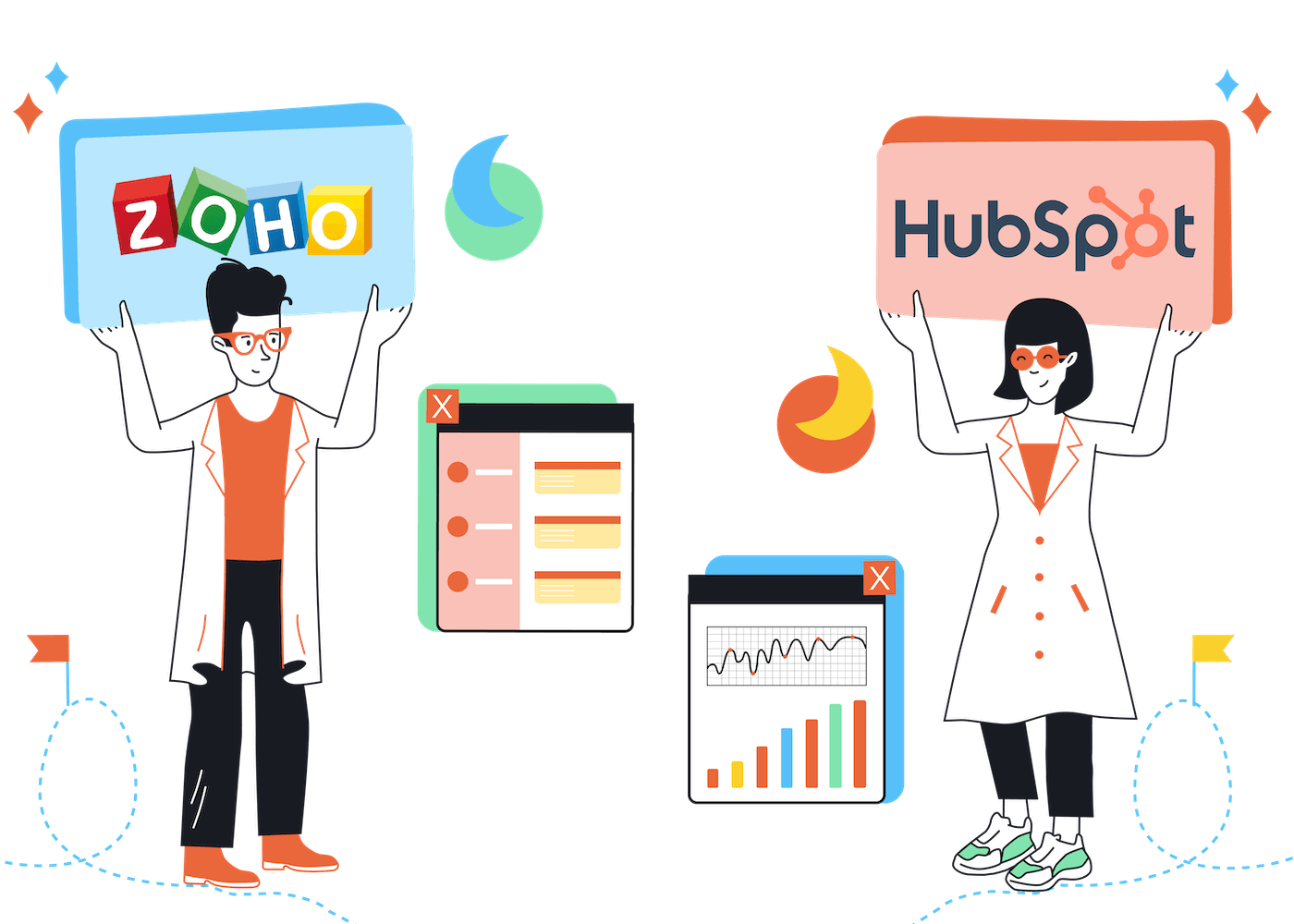EmailTooltester is supported by readers like yourself. We may earn a commission when you purchase through our links. Of course, this won't increase the cost for you.
Deciding between Zoho CRM and HubSpot for your customer relationship management (CRM) software?
HubSpot is a well-known name, thanks to its free CRM offering. You may have also heard of Zoho CRM if your business runs on other Zoho apps (e.g., Zoho Books, Zoho Campaigns, Zoho Sign… there are many of them).
But don’t pick a CRM just based on familiarity. From ease of use to email marketing and pipeline management functionality, there are many other matters to consider.
So, in this Zoho CRM vs HubSpot review, I’ll be putting both platforms through nine comparison rounds to see which one comes out on top.
If you’re impatient to know the result, here’s the TL;DR 👇
What’s the Main Difference Between Zoho CRM vs Hubspot?
The main difference between Zoho CRM and HubSpot is that HubSpot is easier to use and offers more functionality for helping small businesses manage contacts and deals and track their sales efforts. But Zoho CRM’s pricing tiers have smaller price increases between them, which may make the platform the more budget-friendly option as your business scales.
Now, let’s get into the detailed breakdown!
Ease of Use
If your CRM’s features are difficult or tedious to navigate to, you’re gonna have a bad time — especially if you’ll use them often.
With this in mind, I feel Zoho CRM could be easier to use. Some main features are accessible via a top navigation menu, but others — like workflow automations — are buried in the Setup settings. (Which are accessible from the gear icon to the left of your profile pic, in case you were wondering.)
Meanwhile, there’s also a row of small icons at the bottom left of the interface for activity reminders, sticky notes, and more. They’re small and easy to miss.
Try to spot everything I’ve mentioned above in this screenshot of Zoho CRM’s Setup interface (you may take a while to find them all):
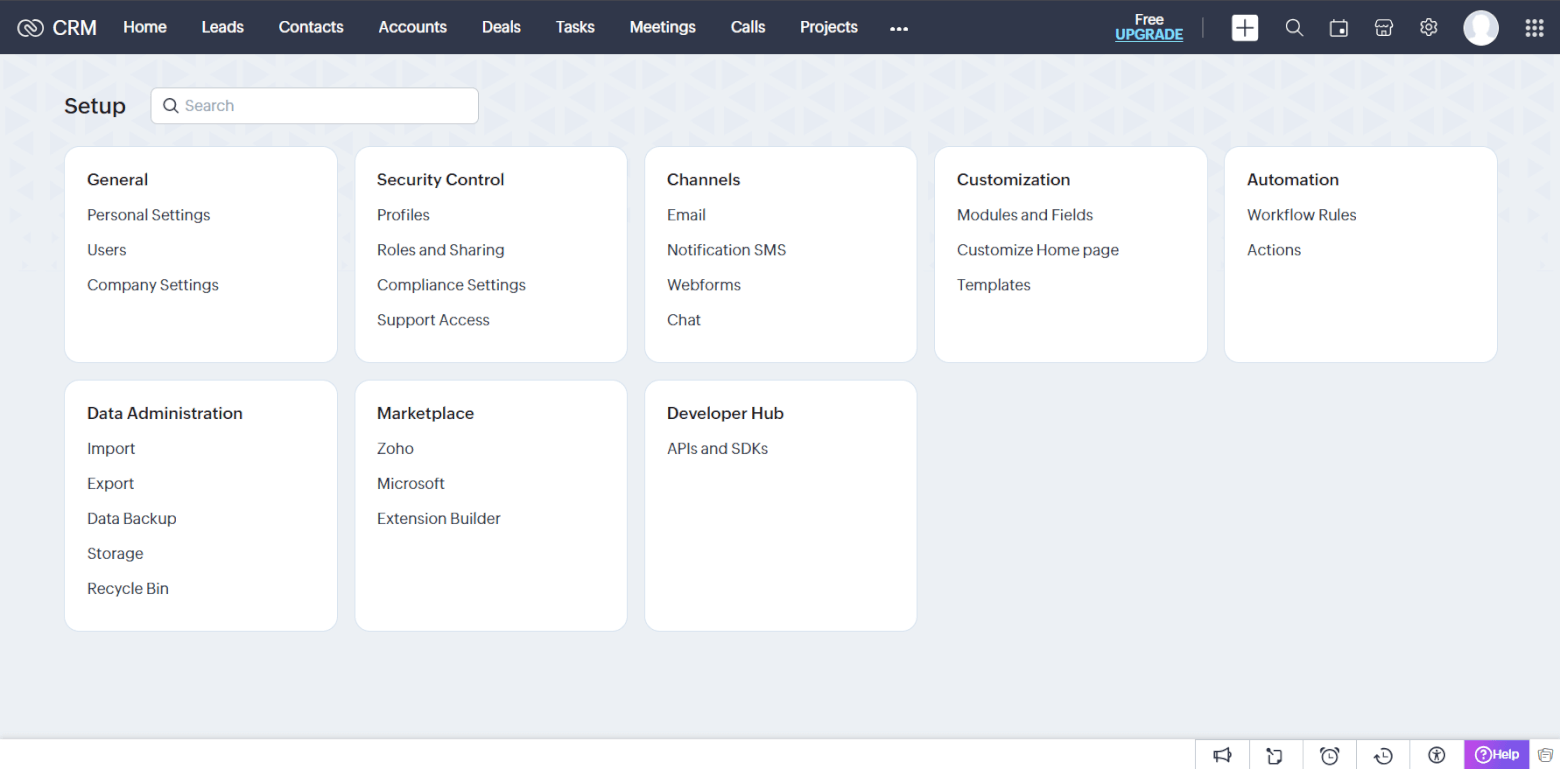
In contrast, HubSpot is simpler to navigate. Once you log in to the dashboard, all the main features are accessible via a left sidebar.
Like Zoho CRM, HubSpot parks some customization settings (e.g., deal properties) in a Settings module rather than putting them with the relevant feature (e.g., Deals).
But at least I can access these settings directly from the feature (e.g., by clicking “Action” > “Edit properties” from the Deals interface). I don’t need to know that I have to go to the Settings module to find them.
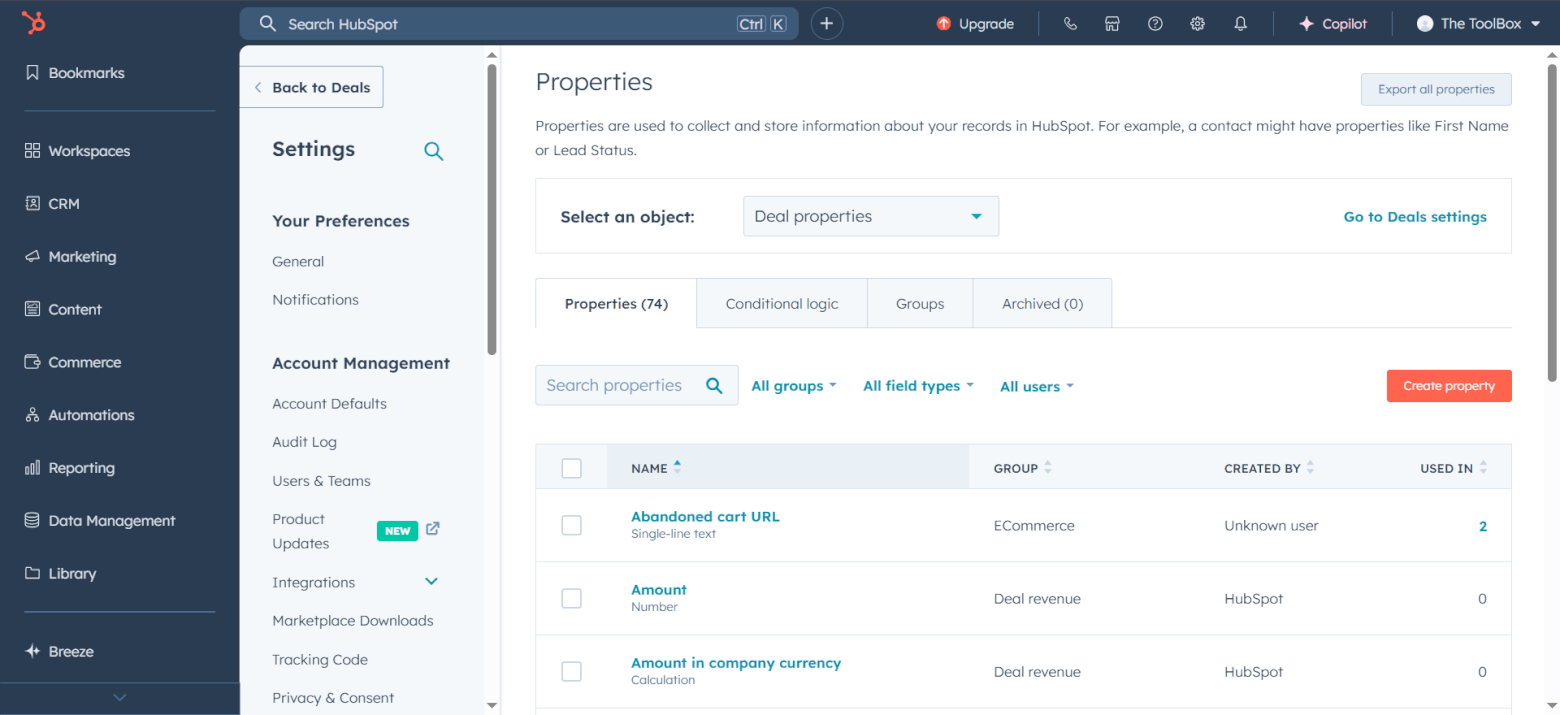
Winner: The first point goes to HubSpot for its more intuitive interface!
HubSpot 1 – Zoho CRM 0
Contact Management
A good CRM should be able to do more than store your contacts’ email addresses and phone numbers. It should also help you track your interaction history with your contacts, segment them based on shared characteristics, and score them to differentiate higher-quality leads from lower-quality ones.
HubSpot offers extensive contact records for keeping track of your contacts’ phone numbers, addresses, deals, email history, notes, and other details. I like the dedicated “Activities” tab for keeping track of conversation history — it makes the interface less cluttered.
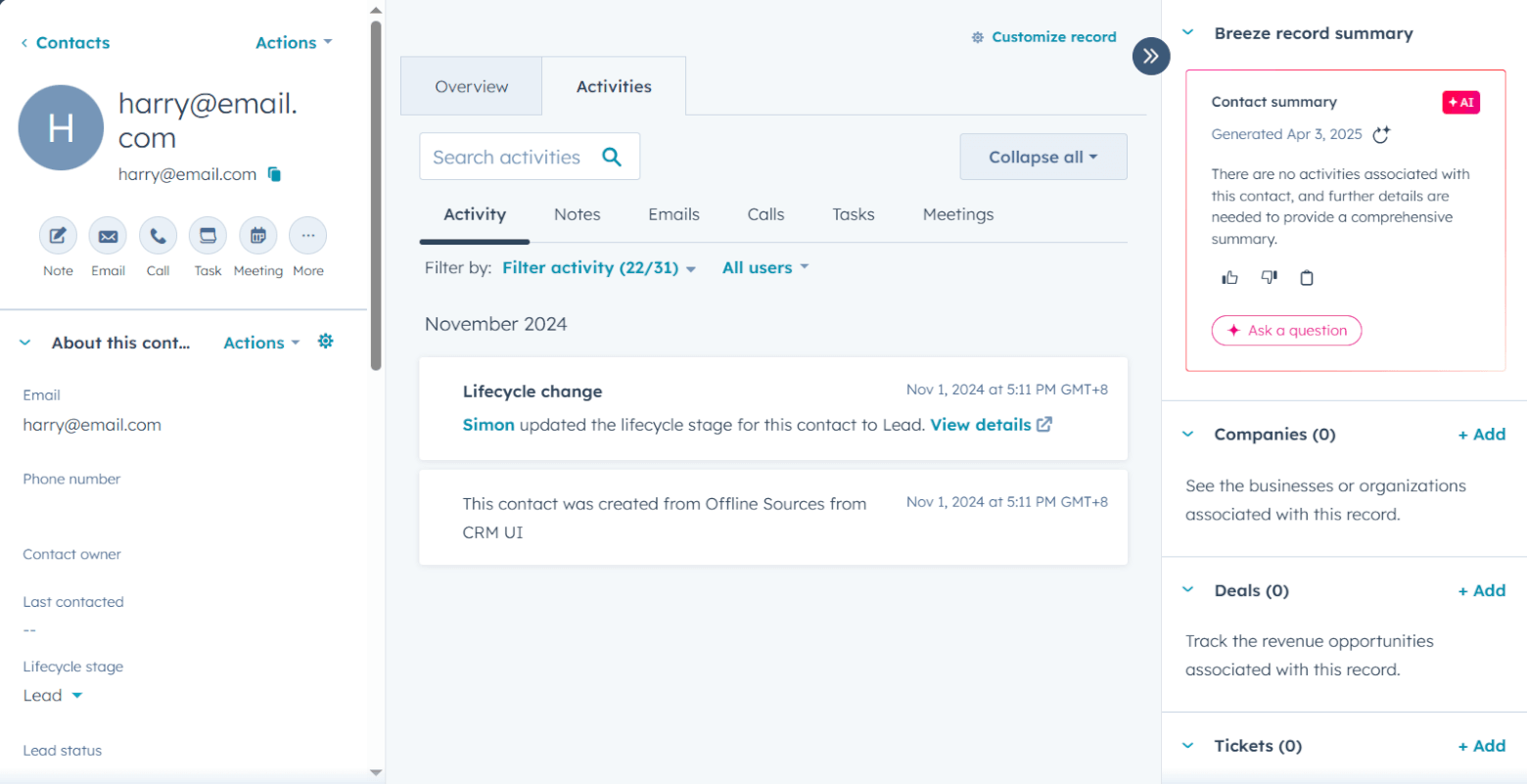
Segmentation is a free feature, and you can segment contacts according to their geographical location, deal properties, and so on.
On the other hand, you’ll need the Professional Customer Platform plan or higher to access lead scoring. Uniquely, though, HubSpot offers a score decay feature. It automatically reduces scores over time to help you manage expectations on whether you’ll close the deal.
Zoho CRM’s contact records are decent, but they aren’t as customizable as HubSpot’s. For instance, you can’t swap the order of the sections for your contacts’ deals and open activities.
Lead scoring is a paid feature. Likewise for contact segmentation — you’ll need at least the Enterprise plan for it. I’m surprised by this pricing decision, considering how segmentation is a basic feature.
Winner: HubSpot is this round’s winner for offering more contact management functionality. Its free plan also lets you segment contacts.
HubSpot 2 – Zoho CRM 0
Customization and Pipeline Management
Next: how do HubSpot and Zoho CRM help you manage your pipelines?
In HubSpot, you can view deals in list and kanban views. If you use kanban view, you’ll get a bird’s eye view of each deal’s stage and their value, plus each stage’s total deal amount.
The stages also show weighted amounts, which are the total deal amounts adjusted for the probability that all deals in that stage close. There are also filters at the top for customizing the deal types you want to see.
And updating your deals’ progress through the pipeline is super easy: just drag and drop them to the correct stage.
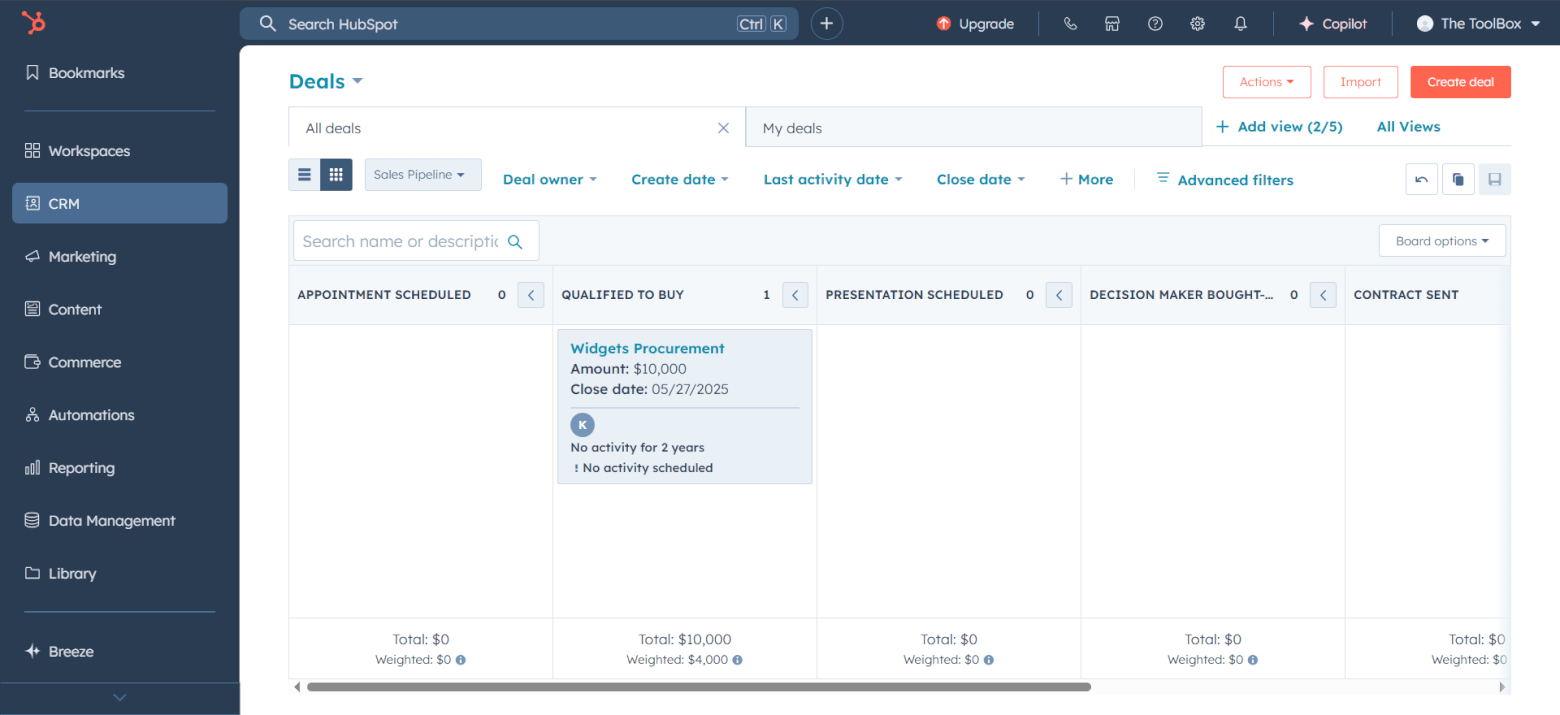
Apart from list and kanban views, Zoho CRM also provides a customizable canvas view for managing your deals in tile or table format. You can filter your deals using the options on the left, but there are fewer filters than what’s available in HubSpot.
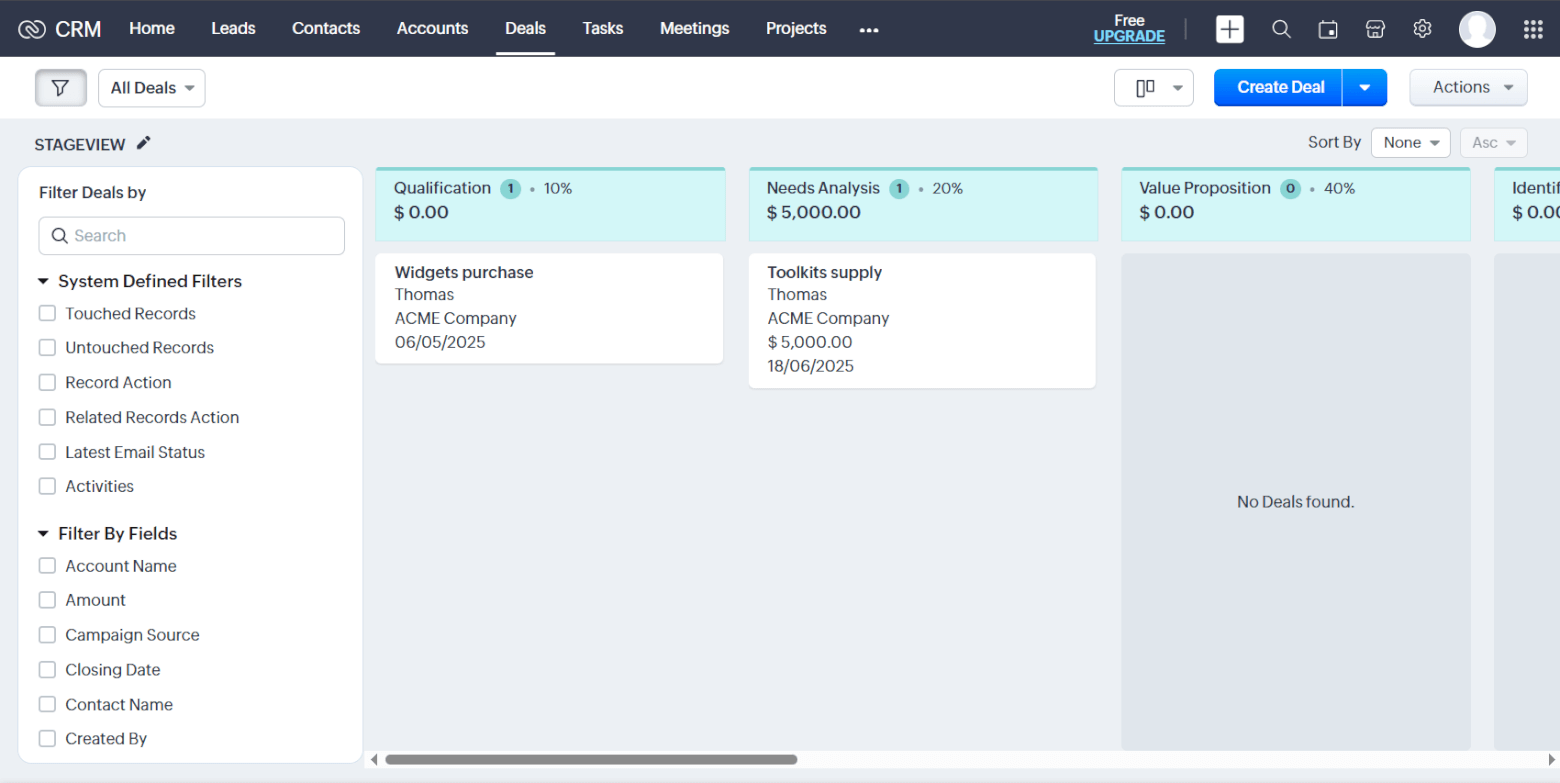
Unlike HubSpot, Zoho CRM’s kanban view doesn’t display weighted deal amounts.
If I have one issue with both platforms, it’s that setting up new pipelines isn’t straightforward. You’ll need to navigate to a separate Settings module to do this.
Winner: There are pros and cons on both sides, so I’m giving one point to each platform. This round ends in a tie.
HubSpot 3 – Zoho CRM 1
Email Marketing
Email marketing is a broad topic. So, I’ll focus on the platforms’ abilities to:
- Create email signup forms.
- Send marketing emails.
- Set up email marketing automations.
Zoho CRM can create autoresponder emails for you to follow up on deals. But for more email marketing functionality, you’ll need to add its sister product, Zoho Campaigns. It has a free plan for sending up to 6,000 monthly emails to 2,000 contacts and setting up email automations, among other functionality.
Zoho Campaigns’s email form templates look dated and have limited customization options. But its email campaign templates are decent, and you can customize them using a drag-and-drop email builder.
For example, you can drag in some useful email content blocks, including dynamic content, polls, and ICS calendar files. But as the email builder’s icons aren’t labeled, they aren’t the most intuitive to use.
Check out the dynamic content icon options on the left of this screenshot, for example. What are they supposed to mean? 😅

Zoho Campaigns provides a few basic email automation templates, and there’s a good number of automation triggers, processes, and actions.
On the other hand, HubSpot offers email marketing features out of the box — you won’t need to install a separate app. Free plan users can send up to 2,000 monthly emails to 1,000 contacts.
HubSpot provides a variety of plain-looking email forms — embedded, popups, dropdown banners, etc. The platform also paywalls a good chunk of its email templates. I find this strange, considering how many competitors make all their email templates free.
HubSpot’s email builder offers fewer content block options than Zoho CRM. But all the essential ones, like text, images, and buttons, are there.
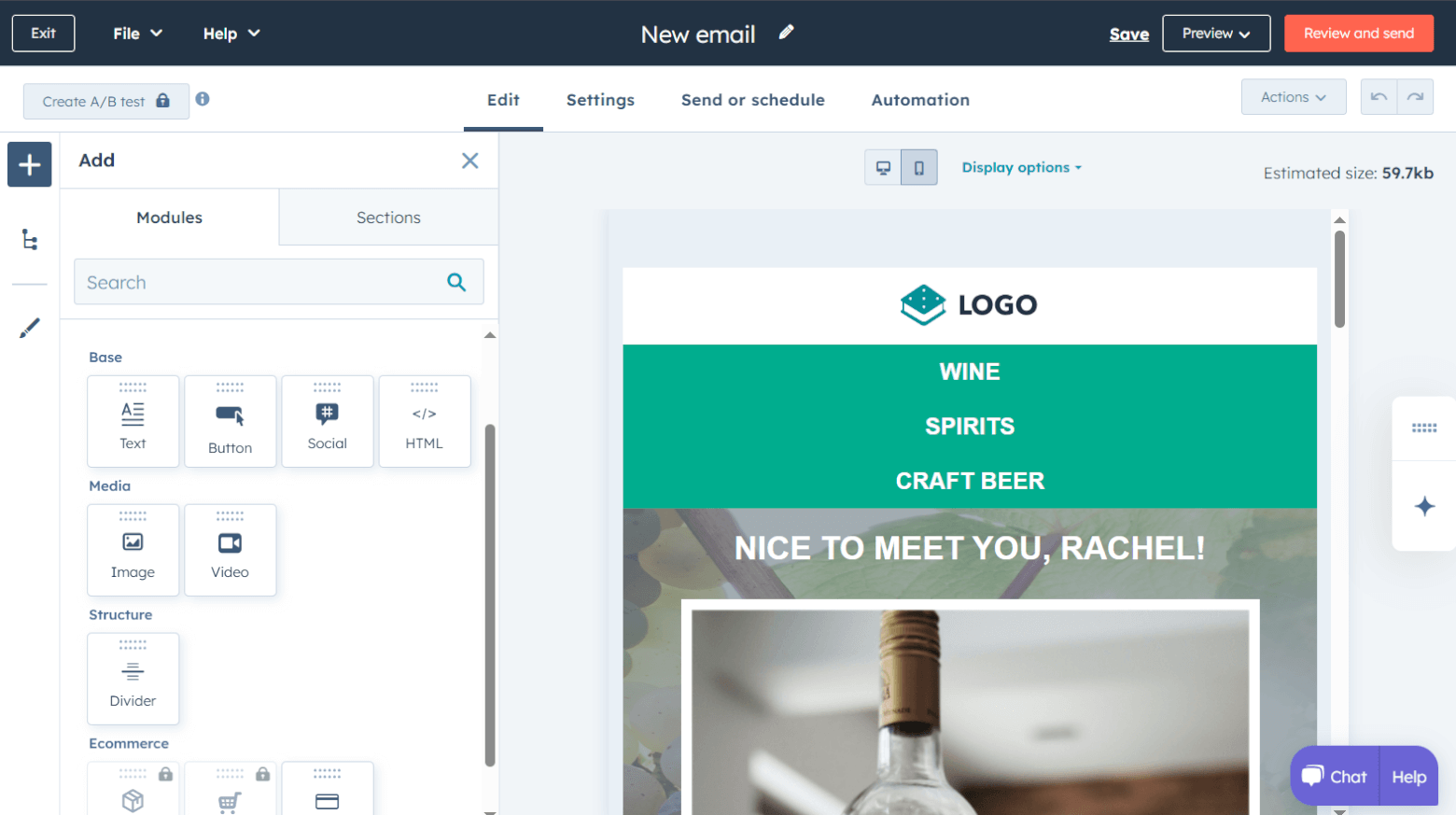
On the email automations front, free plan users can send one automated follow-up email when users subscribe to their form. More sophisticated omnichannel marketing automation is available if you have the Professional Customer Platform plan or higher.
Winner: If you add on Zoho Campaigns, Zoho CRM wins. Zoho Campaigns’s email builder offers more functionality, and you can access all automation features for free.
There are also many other good CRM with email marketing features if you’re interested in alternatives.
HubSpot 3 – Zoho CRM 2
Workflow Automation
When certain events happen, you may have to repetitively update contact records, set up tasks, etc. Don’t do these pesky tasks yourself — check if your CRM can automate them away!
Workflow automation is a paid feature in HubSpot. If you’re on the Starter Customer Platform plan, you’ll get simple sales automation for creating tasks and sending email notifications when deal stages change.
Upgrade to HubSpot’s Professional Customer Platform plan to unlock full functionality, including a wide range of triggers, actions, and conditional branches.
Zoho CRM’s workflow automation feature, called workflow rules, is available on the free plan onward, but it could be more flexible.
Rules are module-specific (modules are categories of data, like leads, deals, and contacts). So, each rule can automate only tasks within a chosen module. You can’t have a rule that automates tasks across multiple modules, like updating a contact followed by updating a deal.
The rules also follow this format: “When X happens, do Y for all the things that meet Z conditions.” This is quite restrictive. For example, you can’t set up what should happen for things that don’t meet Z conditions.
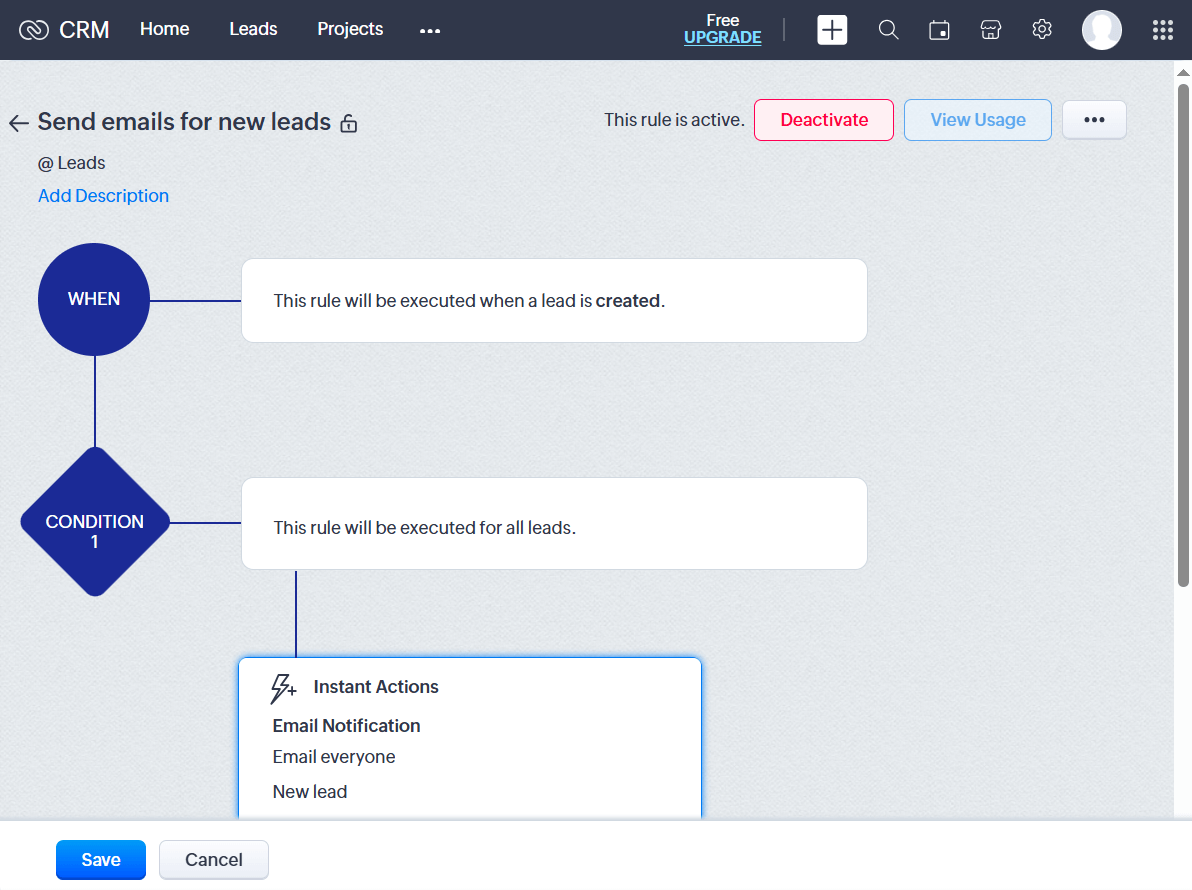
Winner: HubSpot wins here — Zoho CRM’s automation features are clunkier, in comparison.
HubSpot 4 – Zoho CRM 2
Reporting
HubSpot provides over 130 report templates for tracking average deal amounts by sales rep, monitoring total closed deals versus your target number of deals, and more. You can add filters to your reports, and also add reports to dashboards to view multiple reports at once.
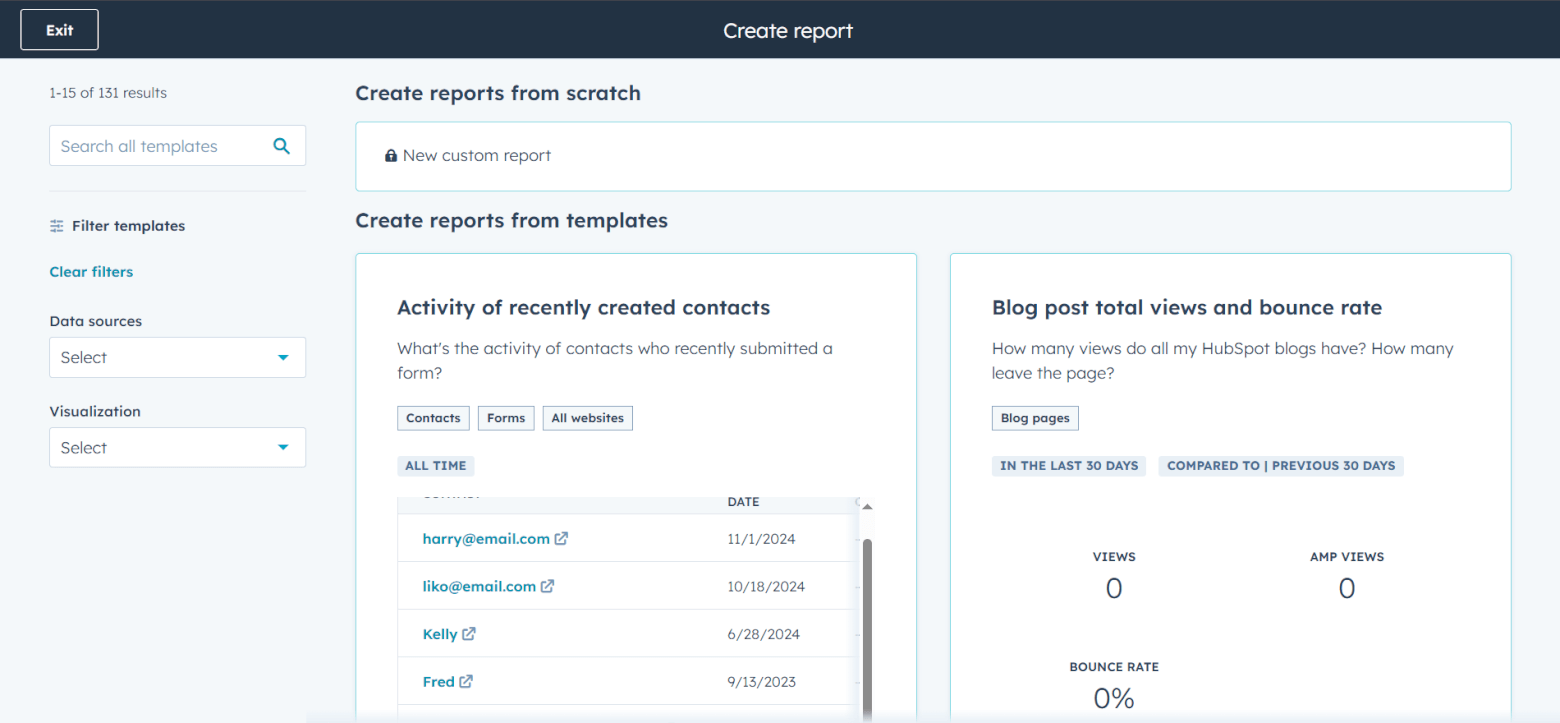
Don’t want to keep logging in to HubSpot to view your reports? The platform can automatically email them to you (and other team members) following your preferred schedule.
Free accounts get up to two dashboards and five reports per dashboard. You’ll need the Professional Customer Platform plan or higher to create custom reports.
Zoho CRM also has a respectable number of built-in reports — more than 60. You can edit their columns and add filters to view the exact data you want to see.
You’ll need to click into each report to view its data, which is displayed in table format by default. If you prefer, you can turn the reports into charts (like pie and bar charts) to visualize their data better. You can’t create reporting dashboards like you can in HubSpot, though.
Scheduled email reports and custom report creation are available if you have a paid plan.
Winner: I’m picking HubSpot. It offers lots more report templates, and you can build dashboards, too.
HubSpot 5 – Zoho CRM 2
AI Features
With AI being all the rage, CRM platforms have been souping up their product with AI — and Zoho CRM and HubSpot are no different.
In Zoho CRM, you’ll get a built-in conversational assistant named Zia, which can help with a whole bunch of tasks. These include predicting business outcomes, detecting customer intents (in emails and calls), and generating and summarizing content.
Uniquely, Zia is multilingual. So, not just English content, but also Spanish and Portuguese content, among other languages. Different features support different languages, though.
Zia is only available on Zoho CRM’s Enterprise plan and higher. So, free users (and even customers on lower tiers) won’t be able to use it.
Zia’s HubSpot counterpart is Breeze Copilot. This conversational assistant, which works only in English, can generate email copy, create contacts and deals, analyze marketing emails, and more.
The best part? Breeze Copilot is available on all plans — even the free one.

Other AI features in HubSpot are:
- Breeze Agents, which are AI software programs that can independently carry out tasks. For example, you can have Breeze Prospecting Agents analyze how to best reach out to prospects, and then execute on the action plan they’ve come up with.
- Breeze Intelligence for automatically populating your contact records with publicly available market data.
Breeze Agents are available on HubSpot’s Professional Customer Platform plan or higher, while Breeze Intelligence is a paid add-on to any paid plan.
Winner: Both platforms have solid AI functionality, but HubSpot gets the point for making its conversational assistant a free feature.
HubSpot 6 – Zoho CRM 2
Integrations
Can Zoho CRM and HubSpot integrate with your apps? Chances are, the answer is yes.
Zoho CRM can integrate with more than 1,000 apps. These apps include other Zoho products (naturally) like Zoho Campaigns and Zoho Forms, plus non-Zoho apps like Asana, Stripe, and Google Analytics.

That said, you’ll need a paid plan to use external integrations. If you’re on the free plan, you’re more or less limited to integrating Zoho apps.
On the other hand, HubSpot makes integrations a free feature and supports more than 1,800 apps. Some standout ones are Gmail, WordPress, and Zoom.
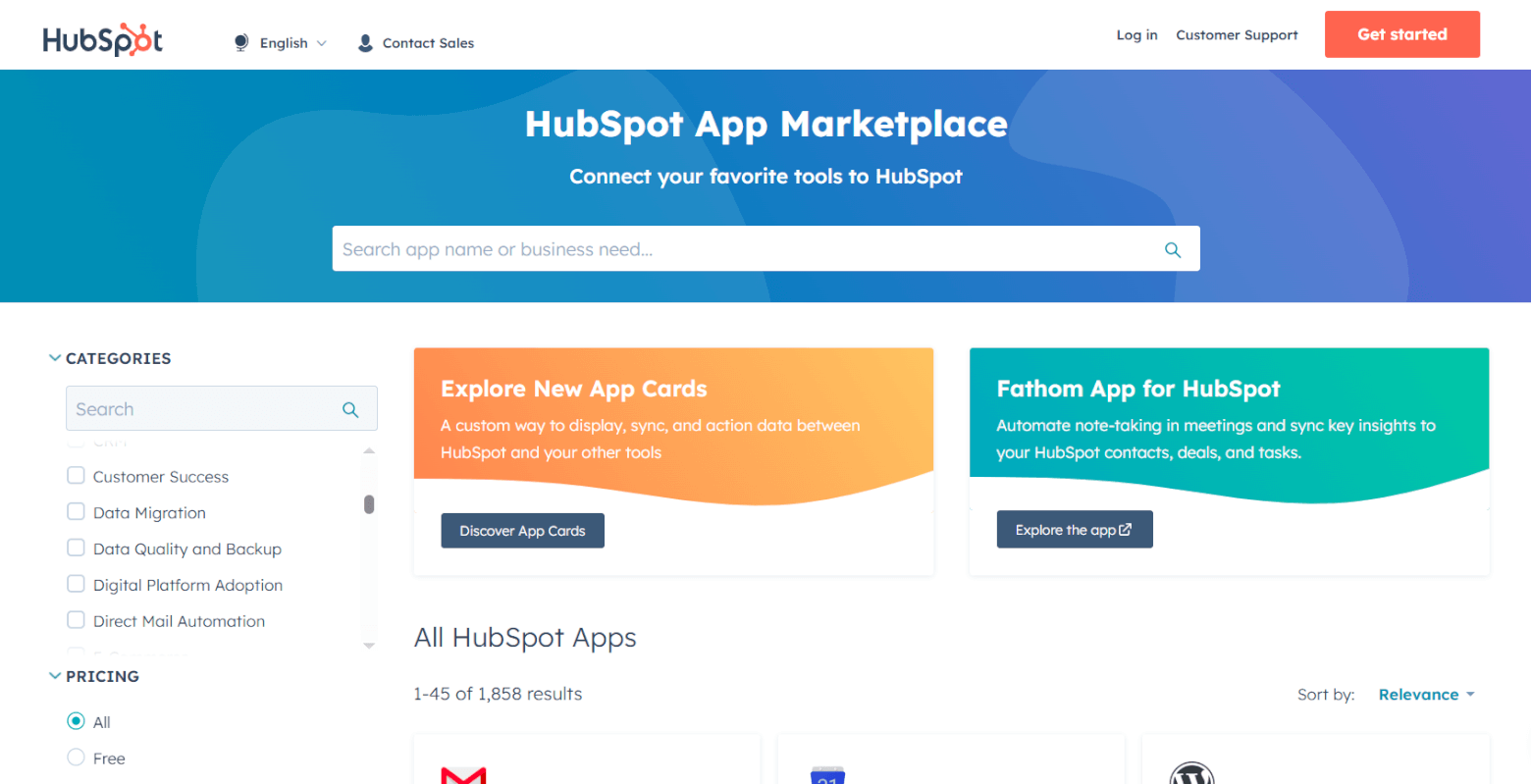
Both Zoho CRM and HubSpot are compatible with Zapier. This is a platform that helps connect apps, and which itself supports 7,000+ apps!
So, even if Zoho CRM or HubSpot doesn’t natively integrate with an app you use, you probably can still integrate the two using Zapier.
Winner: HubSpot wins. It offers integrations for free and also supports more apps than Zoho CRM, making it more likely to be able to integrate with your existing apps. (Do confirm this before you start paying for HubSpot! Likewise if you decide to use Zoho CRM instead.)
HubSpot 7 – Zoho CRM 2
Pricing
Almost at the end now! Let’s wrap up with a general overview of both platforms’ pricing.
Zoho CRM’s free plan accommodates up to three users. It has a good range of features, including one pipeline, five workflow rules, and 10 custom email templates. Integrations and AI features are notable paid features, as mentioned earlier.
There’s a $10+ jump in prices between Zoho CRM’s paid plans, which is reasonable:
- Standard: $14/user/month
- Professional: $23/user/month
- Enterprise: $50/user/month
- Ultimate: $65/user/month
(These prices are based on monthly billing.)
Meanwhile, HubSpot’s free plan is generous. It accommodates up to two users and offers one pipeline, 2,000 monthly email sends, up to 1,000 contacts, one automated follow-up email per form, and Breeze Copilot, among other features.
Paid functionality includes (most) email templates, and full-featured sales and omnichannel marketing automation.
To upgrade your HubSpot account’s CRM and email marketing features, you’ll need a paid Customer Platform plan. And the price jump between them is huge:
- Starter: $20/month/seat and up
- Professional: $1,450/month for five seats (additional seats start at $50/month)
(These prices are based on monthly billing.)
Doing the math, your first five Professional plan seats cost $290/month/seat, which is a 14.5X increase 😶
Winner: Zoho CRM wins the pricing battle. HubSpot’s free plan might work for small businesses in the beginning. But if you need more CRM firepower as you scale, you might find HubSpot’s Professional Customer Platform plan pricing too tough to swallow.
HubSpot 7 – Zoho CRM 3
Zoho CRM vs HubSpot: Final Thoughts
Totaling up the scores, HubSpot has seven points, while Zoho CRM has three. The winner of our Zoho CRM vs HubSpot review is therefore HubSpot!
Be it contact management, workflow automation, or the other categories I looked at, HubSpot is generally the easier-to-use and more feature-packed platform.
Its free plan is also great, but think about whether you can commit to the high Professional Customer Platform plan pricing if you end up needing to. After all, switching CRMs can be a hassle.
Try both platforms at no cost using the convenient links below:
And if neither Zoho CRM nor HubSpot tickles your fancy, no worries! Explore other options in our guide to the best CRMs for small businesses.
Have questions on Zoho CRM and HubSpot? Leave a comment below, and we’ll get back to you.
Our Methodology
This article has been written and researched following our EmailTooltester methodology.
Our Methodology